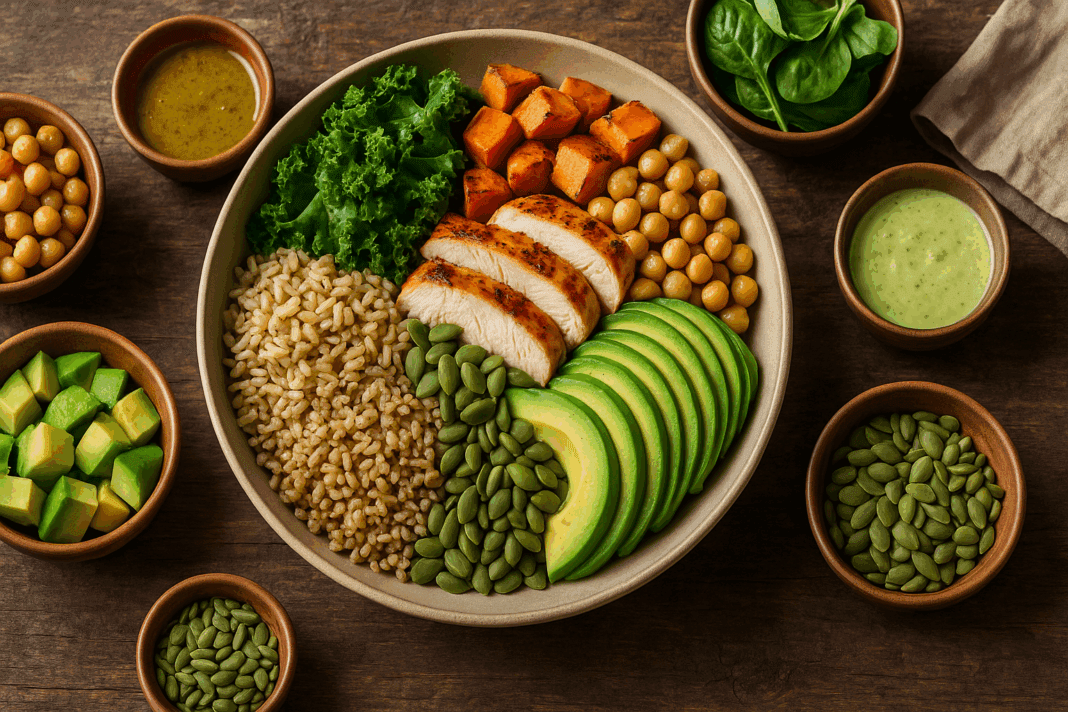When people think of salads, the image that most often comes to mind is a small bowl of lettuce with a few scattered vegetables. But this outdated view does a disservice to one of the most versatile and nourishing meals possible. Salads, especially when designed with intention, can be both satisfying and nutrient-dense, making them ideal not just as a side dish, but as a complete dinner solution. Today, more people are embracing hearty salad recipes for dinner that are not only health-conscious but also rich in flavor, texture, and variety. These aren’t just salads for dinner in the minimalist sense; they are fully realized meals capable of keeping you full, energized, and satisfied well into the evening.
You may also like: Delicious Meets Nutritious: How to Create Healthy Food with Flavor Using Expert-Backed Diet Recipes and Cooking Tips
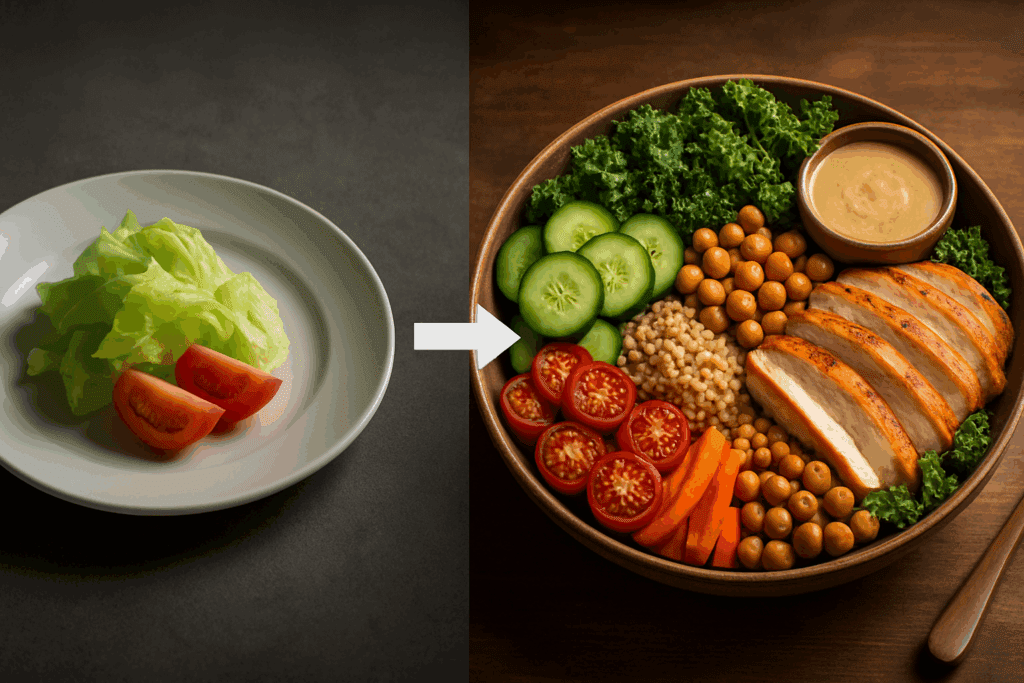
Understanding the Shift Toward Salads as Complete Meals
The cultural perception of salads has shifted dramatically in recent years, thanks in part to a growing awareness of nutrition science and a broader movement toward whole foods. In the past, dinner salad ideas were often limited to dieters seeking to cut calories. But with modern culinary innovation and deeper nutritional insight, salad meals have evolved into something much more holistic. A salad for dinner can now include elements like high-quality proteins, complex carbohydrates, healthy fats, and fiber-packed greens, all thoughtfully combined into a single, balanced dish.
Medical professionals and registered dietitians increasingly support this trend, especially for individuals aiming to manage weight, reduce inflammation, or improve metabolic health. Nutrient-dense salads for dinner can help regulate blood sugar, provide long-lasting energy, and support digestive health. Unlike high-sodium, processed dinners or fast food options, hearty salads offer a refreshing alternative that is both customizable and deeply nourishing. This approach aligns with the principles of preventive health, making salad meals a strong candidate for long-term wellness support.
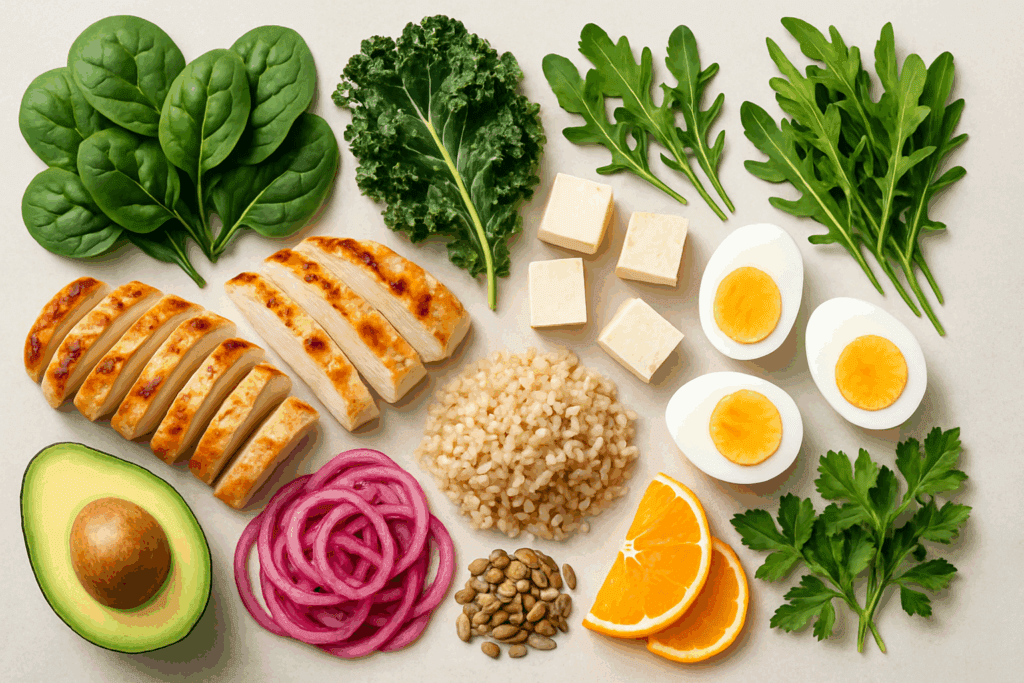
The Anatomy of a Hearty Salad
What exactly transforms a salad into a hearty, filling meal? The answer lies in the composition. A successful dinner salad is built from components that serve both culinary and physiological purposes. First, a variety of greens forms the foundation—think beyond iceberg to include arugula, kale, romaine, and spinach, each offering unique nutrients and textures. Next, hearty salad recipes benefit from the addition of proteins such as grilled chicken, tofu, hard-boiled eggs, chickpeas, or seared salmon. These not only enhance satiety but also support muscle repair and hormonal balance.
Carbohydrates are also essential, particularly complex ones like quinoa, brown rice, roasted sweet potatoes, or whole-grain pasta. These elements ensure that your salad for dinner doesn’t leave you reaching for a snack an hour later. Healthy fats from avocados, olives, nuts, seeds, or homemade vinaigrettes provide flavor, texture, and support for the absorption of fat-soluble vitamins. And don’t forget a layer of crunch or brightness from elements like pickled onions, roasted chickpeas, fresh herbs, or a citrus splash—these finishing touches elevate the eating experience and contribute to a sense of completeness.
Nutritional Considerations Backed by Experts
Leading voices in the field of nutrition emphasize the value of balance when designing salad meals. According to Harvard’s School of Public Health, meals rich in fiber, lean protein, and healthy fats help maintain a healthy weight and lower the risk of chronic disease. Salads that include a wide range of plant-based ingredients introduce an array of phytonutrients, antioxidants, and fiber into your diet, supporting heart health and reducing inflammation.
From a functional nutrition perspective, hearty salad recipes can also be customized for specific dietary needs, such as gluten-free, low FODMAP, plant-based, or Mediterranean-style. This adaptability ensures that salads for dinner can fit into nearly any dietary framework without compromising taste or satisfaction. Importantly, a well-rounded salad for dinner also meets the body’s need for essential micronutrients such as magnesium, potassium, and folate, which play a key role in cardiovascular and metabolic functions.
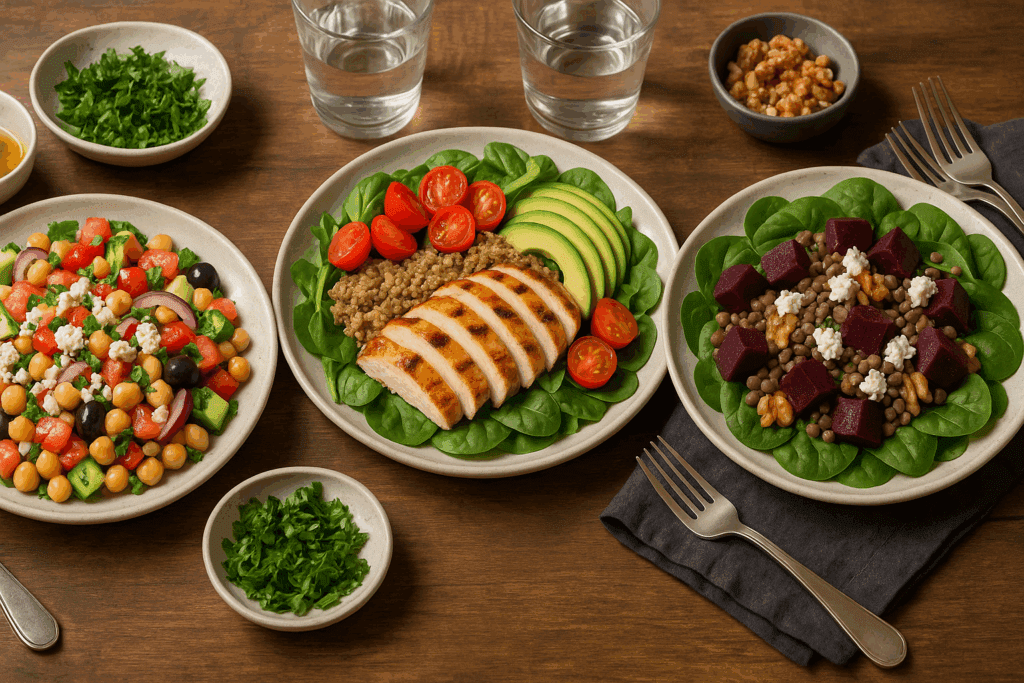
Dinner Salad Ideas That Satisfy and Nourish
One of the most exciting aspects of incorporating salads into your dinner routine is the creative freedom it allows. Dinner salad ideas can range from warm grain bowls with roasted vegetables to chilled salads bursting with seasonal fruit, goat cheese, and candied pecans. One classic yet endlessly customizable idea is the Mediterranean chickpea salad, which combines cucumbers, tomatoes, Kalamata olives, feta, and a lemon-oregano vinaigrette. This dish exemplifies how salads for dinner can offer both robust flavor and nutrition.
Another favorite among nutrition experts is a grilled chicken and quinoa salad featuring roasted bell peppers, arugula, sunflower seeds, and a creamy avocado-lime dressing. It’s a complete meal that delivers on taste and keeps you full thanks to its protein and fiber content. For plant-based eaters, a lentil and roasted beet salad over a bed of baby spinach, finished with walnut oil and balsamic reduction, delivers iron, protein, and essential fatty acids all in one plate. These hearty salad recipes prove that salads aren’t just a prelude to the main course—they are the main course.
Making Salads Convenient for Busy Lives
One of the biggest obstacles to healthy eating is often time. People assume that making hearty salad meals requires extensive prep, but with a few strategies, it can be one of the quickest dinner options available. Batch-prepping salad components at the start of the week—chopping vegetables, cooking grains, preparing dressings, and roasting proteins—can make it easy to throw together nutritious salad meals in under ten minutes. This approach makes salads for dinner a realistic option even on your busiest nights.
Moreover, storing ingredients properly can keep them fresh longer. Greens stay crisp when stored with a paper towel in a sealed container, and roasted vegetables can be refreshed with a quick warm-up. Having elements like hummus, tahini dressing, or marinated beans on hand allows you to assemble dinner salad ideas on demand with minimal effort. For people navigating dietary goals, the ability to control ingredients and portion sizes makes hearty salad recipes a preferred choice over takeout or frozen meals.
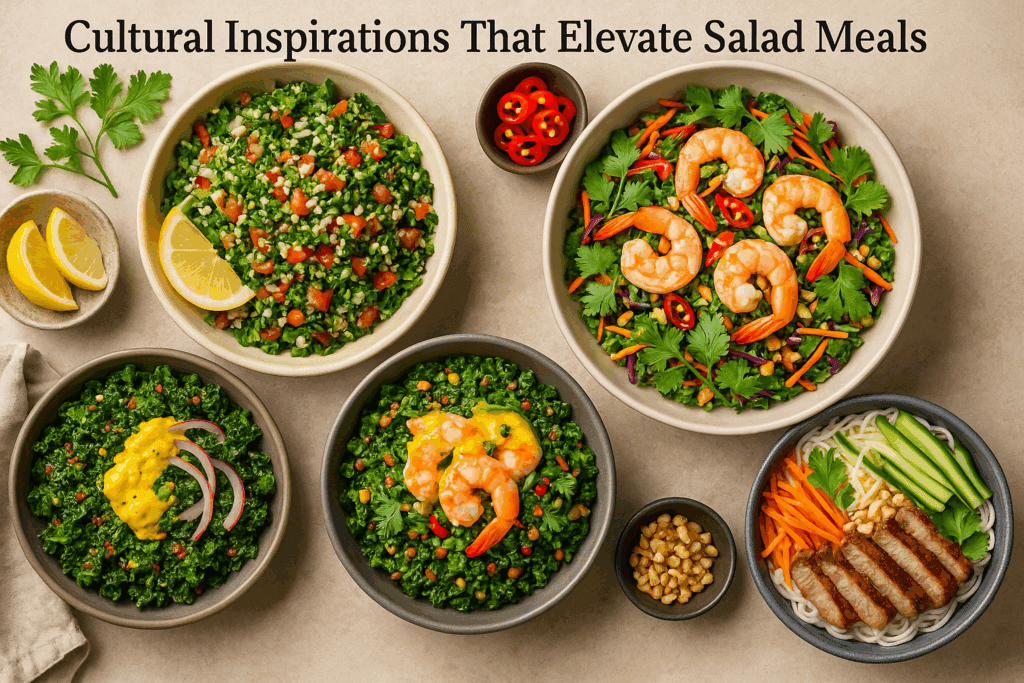
Cultural Inspirations That Elevate Salad Meals
Global cuisines offer endless inspiration for crafting salad meals that are both hearty and exciting. Middle Eastern tabbouleh, Vietnamese vermicelli bowls, and Mexican taco salads all provide examples of how different cultures use fresh ingredients, herbs, and protein combinations to build complete meals in salad form. These global traditions often emphasize balance, flavor layering, and the use of nutrient-dense whole foods—all principles echoed in modern preventive wellness and nutritional science.
Take, for example, a Thai-inspired salad featuring shredded cabbage, carrots, cilantro, grilled shrimp, and a spicy peanut dressing. This kind of dish brings together crunch, spice, protein, and freshness in a way that delights the palate while supporting balanced nutrition. Likewise, an Indian-themed kale salad with warm spiced lentils, golden raisins, and a turmeric yogurt dressing offers a beautiful mix of earthy, sweet, and tangy notes. Drawing from international cuisine not only broadens your culinary horizons but ensures you never grow bored with your salad for dinner routine.
The Role of Salads in Weight Management and Metabolic Health
Multiple studies suggest that incorporating more whole foods, particularly vegetables, legumes, and lean proteins, can significantly support weight loss and metabolic function. Hearty salad recipes inherently fulfill these dietary requirements. By emphasizing fiber and nutrient-dense foods over refined carbs and processed meats, salads help stabilize blood glucose and promote satiety. This effect is particularly valuable for individuals managing type 2 diabetes, insulin resistance, or elevated cholesterol levels.
Furthermore, a salad for dinner allows you to eat generously without overeating calories, thanks to the high volume and low energy density of many vegetables. This strategy, often referred to as “volumetrics” in nutritional literature, can make it easier to reduce overall calorie intake without feeling deprived. Experts recommend including a variety of textures and flavors to reduce palate fatigue, which can derail healthy eating plans. From this standpoint, dinner salad ideas become a powerful tool in both weight control and the prevention of chronic illness.
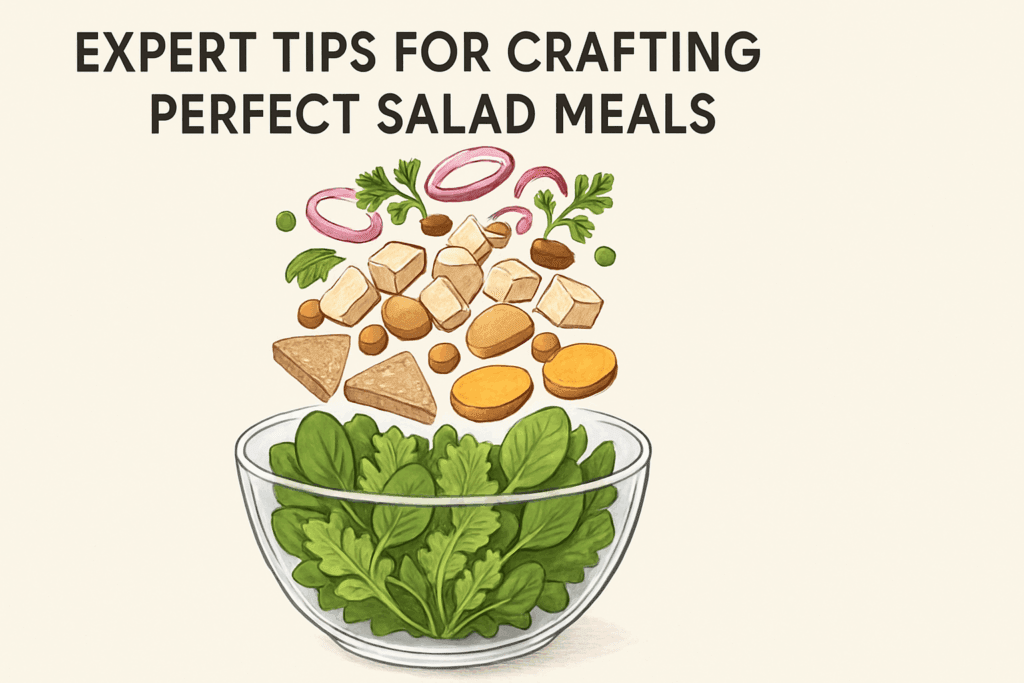
Expert Tips for Crafting Perfect Salad Meals
While there’s no single formula for the perfect salad, experts recommend certain guiding principles to ensure your salad meals are as satisfying as they are health-promoting. First, include a minimum of four to five food groups in every salad. This might mean pairing dark leafy greens with a protein, a complex carbohydrate, a healthy fat, and a flavorful topper like herbs or pickled vegetables. Second, vary your colors and textures—this not only makes your meals more visually appealing but also increases the range of nutrients consumed.
Another professional tip is to watch your dressings. Many store-bought dressings are high in sodium, sugar, and processed oils. Making your own with ingredients like olive oil, mustard, lemon juice, tahini, or Greek yogurt gives you control and boosts the nutritional value. Finally, don’t underestimate the importance of seasoning. A pinch of sea salt, a grind of black pepper, or a sprinkle of za’atar can elevate your salad from bland to crave-worthy, ensuring that your hearty salad recipes remain a staple in your dietary rotation.
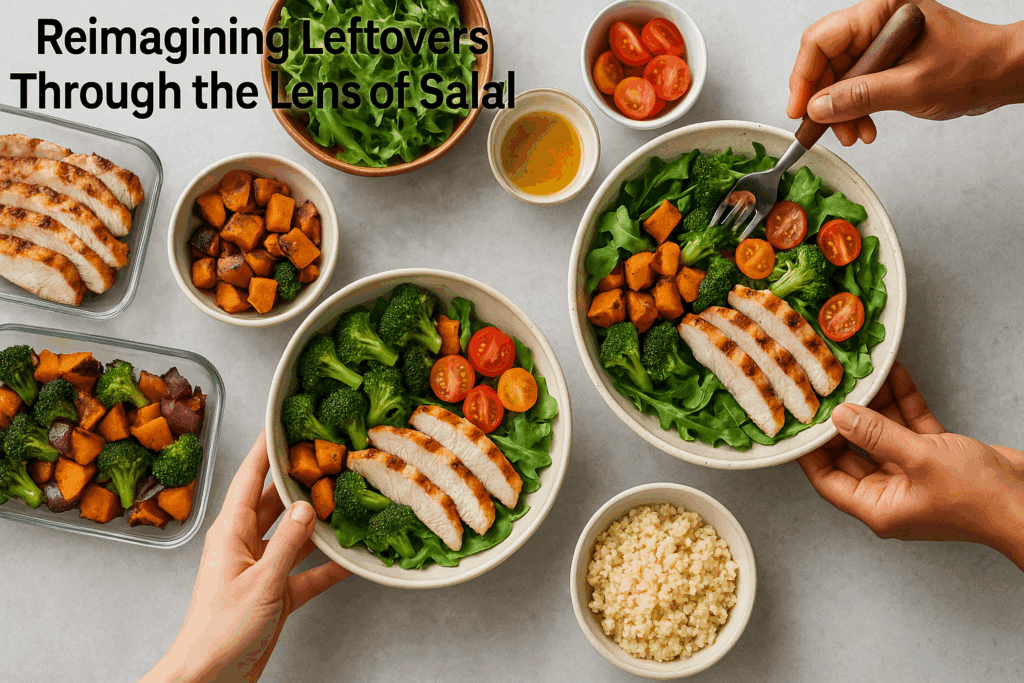
Reimagining Leftovers Through the Lens of Salad
One of the most practical and underrated uses of salad meals is their ability to transform leftovers into something new and exciting. Grilled vegetables from last night’s dinner, roasted chicken from Sunday meal prep, or a scoop of leftover couscous can all be repurposed into nourishing salad for dinner options. This not only reduces food waste but also makes meal planning more efficient.
A base of greens and a thoughtful dressing can reinvent even the most modest ingredients. For instance, leftover stir-fried tofu and broccoli can be tossed with shredded cabbage and a sesame vinaigrette for an Asian-style slaw. Even more unexpected items, like fruit that is slightly past peak ripeness, can be diced and added to grain salads for a touch of natural sweetness. The flexibility and adaptability of salad meals ensure they can meet your nutritional needs while respecting your time and budget.
Why Salads Belong at the Center of the Plate
Culturally, there is still some resistance to the idea of salads as dinner-worthy meals. Many people associate hearty dishes with warm, heavy comfort foods. But redefining what makes a meal satisfying is essential in today’s health landscape. Hearty salad recipes challenge the outdated notion that dinner must be centered around meat and starch. Instead, they prove that a dish can be light in calories yet dense in nutrients and satisfaction.
More than just a food trend, salads for dinner represent a lifestyle shift toward intentional eating, where each ingredient is selected not only for its taste but for its contribution to well-being. The growing number of restaurants that now feature salad meals as centerpieces of their menus reflects this evolution. As more people seek meals that balance enjoyment and nutrition, hearty salad recipes continue to rise in popularity and relevance.
Frequently Asked Questions (FAQ): Hearty Salad Recipes for Dinner
1. Can hearty salad meals be prepared in advance without compromising freshness or nutrition? Absolutely. One of the advantages of hearty salad recipes is their ability to be prepped in advance while maintaining both flavor and nutritional value. To keep salad meals fresh, store components like greens, proteins, and dressings separately and assemble just before serving. Ingredients such as roasted vegetables, cooked grains, and marinated proteins can even improve in taste after refrigeration. By using airtight containers and moisture-controlling methods, such as paper towels layered with greens, your salad for dinner can taste just as vibrant days later. Prepping ahead also allows for greater flexibility in exploring various dinner salad ideas throughout the week.
2. What are some ways to make salads for dinner more appealing to children or picky eaters? Transforming salad meals into a fun, engaging experience is key when introducing them to children. Start by allowing them to choose their own toppings, such as colorful vegetables, cheese, or fruit, which gives them a sense of ownership over their meals. Incorporating familiar flavors—like grilled chicken strips or small pasta shells—within hearty salad recipes can ease them into trying new textures and ingredients. Use visually appealing elements, like spiralized carrots or heart-shaped cucumber slices, to add novelty. Over time, rotating different salad for dinner options exposes them to variety without overwhelming their palates.
3. How can I include seasonal ingredients in my dinner salad ideas year-round? Integrating seasonal produce into salads for dinner not only supports local agriculture but also boosts flavor and nutritional diversity. In spring, try pea shoots, asparagus tips, or strawberries. Summer opens the door to tomatoes, sweet corn, and stone fruits, while autumn offers roasted squash, apples, and nuts. Winter calls for hearty ingredients like citrus, kale, and pomegranate seeds, which add brightness to otherwise dense salad meals. These rotations keep hearty salad recipes exciting and nutritionally aligned with the body’s needs across changing seasons.
4. Are there scientific benefits to eating hearty salads at night rather than earlier in the day? Emerging research suggests that lighter, nutrient-dense meals in the evening may support better sleep and digestion, making a hearty salad an optimal choice for dinner. Salads for dinner are naturally lower in saturated fats and refined carbs, which are known to interfere with sleep quality. When packed with magnesium-rich greens, tryptophan-containing proteins, and healthy fats, salad meals can promote calm and relaxation before bed. Additionally, the high fiber content in hearty salad recipes helps regulate blood sugar levels overnight. Choosing a salad for dinner may, therefore, offer metabolic and circadian rhythm benefits.
5. How can I ensure my salad for dinner has enough calories for athletes or high-energy individuals? For those with higher caloric needs, hearty salad recipes should emphasize energy-dense yet nutrient-rich ingredients. Adding generous portions of avocado, quinoa, legumes, nuts, seeds, and olive oil-based dressings can significantly increase the caloric profile of your salad meals. Including double portions of proteins like salmon or grilled tofu also supports muscle repair and recovery. Using whole grains and roasted root vegetables helps maintain energy for endurance activities. Even among athletes, salads for dinner can provide a complete and satisfying nutritional profile when built intentionally.
6. What are some overlooked ingredients that can add depth to hearty salad meals? While most people think of lettuce and tomatoes first, lesser-known ingredients can transform dinner salad ideas into culinary revelations. Roasted grapes, pickled fennel, miso-glazed eggplant, or grilled citrus segments add unexpected layers of flavor. Textural contrasts such as crispy shallots, marcona almonds, or toasted farro enhance mouthfeel. Additionally, infusions like smoked paprika oil or tahini-turmeric dressings can elevate ordinary salad meals. These additions showcase how creative ingredient combinations redefine the experience of a salad for dinner.
7. Is it possible to use leftovers from other meals to create hearty salad recipes? Repurposing leftovers is one of the most efficient ways to craft salad meals that are both economical and sustainable. For example, last night’s grilled chicken or roasted vegetables can be tossed into greens with a fresh vinaigrette for an entirely new take on salads for dinner. Leftover lentils, beans, or couscous become flavorful bases when paired with complementary dressings and toppings. Even soups or stews can be reduced into a thick relish and served over grains in hearty salad bowls. Utilizing leftovers not only reduces food waste but also provides creative and personalized dinner salad ideas.
8. What are the psychological or emotional benefits of choosing salads for dinner regularly? Beyond physical health, the ritual of preparing and consuming hearty salad recipes can enhance emotional well-being. Studies show that meals high in colorful vegetables are associated with improved mood and reduced stress, due to the high presence of micronutrients that support brain health. Creating salad meals also fosters mindfulness, especially when sourcing ingredients intentionally or preparing them with care. Additionally, consistent consumption of balanced, vibrant meals like a salad for dinner may reinforce a sense of agency in managing one’s health. Over time, this can contribute to greater self-efficacy and a more positive relationship with food.
9. How do plant-based eaters ensure variety and complete nutrition in salad meals? Plant-based diners can enjoy deeply satisfying salad for dinner options by incorporating a strategic mix of legumes, nuts, seeds, and whole grains. Using different types of lentils, beans, and fermented soy like tempeh ensures adequate protein intake. Pairing ingredients rich in vitamin C, such as bell peppers or citrus, with iron-rich foods like spinach enhances nutrient absorption. Diversity in textures and global flavors—such as African peanut dressing or Korean gochujang—prevents meal fatigue and keeps hearty salad meals dynamic. With the right combinations, dinner salad ideas can support complete plant-based nutrition without sacrificing satisfaction.
10. What innovations in food technology are influencing modern hearty salad recipes? Food innovation is increasingly shaping the future of salad meals in exciting ways. High-protein chickpea pastas, nutrient-dense seaweed-based seasonings, and probiotic-enhanced dressings are just a few examples redefining what a salad for dinner can be. Vertical farming and hydroponics now deliver ultra-fresh greens with enhanced flavor and shelf life, while AI-generated flavor pairings inspire bold new dinner salad ideas. Lab-grown meats and plant-based seafood substitutes also allow for sustainable, protein-rich additions to hearty salad bowls. These technological advancements are expanding the horizon of hearty salad recipes, making them even more diverse, convenient, and environmentally conscious.
The Bottom Line: Embracing Hearty Salad Recipes for Dinner with Confidence and Creativity
Salads have long been underestimated, relegated to the margins of the dinner table or dismissed as mere diet fare. But today’s approach to hearty salad recipes reclaims their rightful place as vibrant, satisfying, and deeply nourishing meals that can serve as the foundation of a healthy lifestyle. Whether you’re crafting salad meals to meet specific nutritional goals, exploring creative dinner salad ideas, or simply looking for a refreshing way to eat well without sacrificing flavor, a well-composed salad for dinner delivers.
When built thoughtfully, salads for dinner can include everything your body needs to thrive: fiber, protein, healthy fats, micronutrients, and complex carbs. Their flexibility makes them accessible to all types of eaters and adaptable to virtually any cuisine. Backed by expert guidance, endorsed by nutrition science, and celebrated for their convenience and creativity, these meals offer a sustainable path to better health. By embracing the full potential of salad meals, we open the door to a dinner experience that is not only enjoyable but profoundly beneficial.
With the right ingredients, a bit of preparation, and a sense of culinary adventure, dinner salad ideas transform from an afterthought into the main event. The next time you wonder what to make for dinner, consider a hearty salad: simple, nourishing, endlessly customizable, and always in season.
Further Reading:
21 Salads That We’d Be Happy to Eat for Dinner
26 Salads So Delicious, You’ll Want to Eat Them for Dinner
42 Hearty Dinner Salad Recipes the Whole Family Will Love


